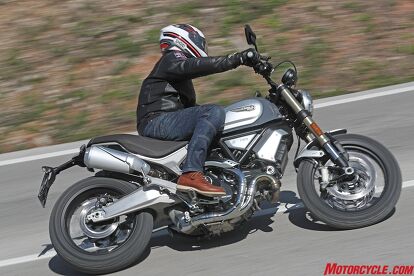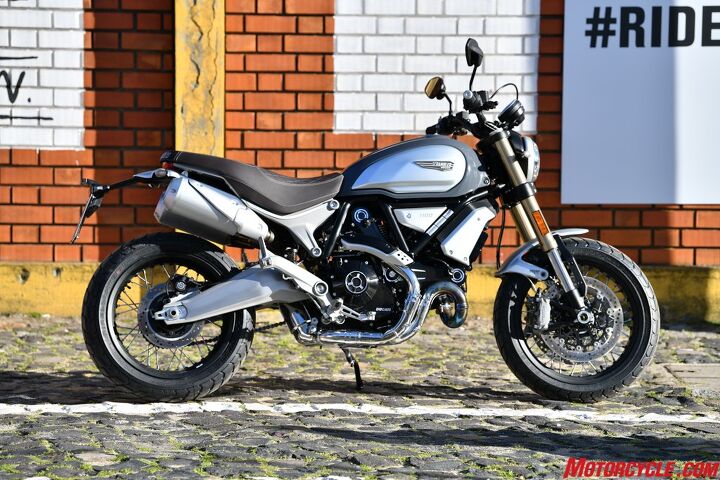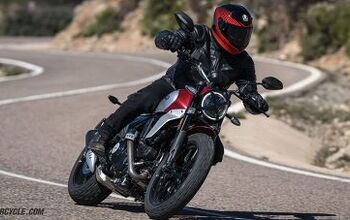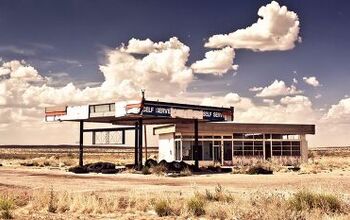2018 Ducati Scrambler 1100 First Ride Review

Because even non-conformists believe bigger is better
For a company priding itself on racing and performance, there’s an irony in the fact that, since its introduction in 2014, the Scrambler has been Ducati’s best selling model. Eschewing performance in favor of simplicity and riding enjoyment, the Scrambler charts a different path for Ducati, and the folks in Borgo Panigale have embraced this concept wholeheartedly.
2018 Ducati Scrambler 1100
| Engine | 18.5/20 |
| Suspension/Handling | 12.0/15 |
| Transmission/Clutch | 10/10 |
| Brakes | 9.0/10 |
| Instruments/Controls | 3.0/5 |
| Ergonomics/Comfort | 8.5/10 |
| Appearance/Quality | 8.0/10 |
| Desirability | 9.0/10 |
| Value | 7.0/10 |
| Overall Score | 85/100 |
Ducati arguably didn’t create the Scrambler scene, but it’s fair to say the lifestyle blossomed to what it is today thanks to Ducati. A brand valuing individualism, exploration, irreverence, and wonder, this is why the Scrambler has been so popular; it delivers the riding experience with no pretensions and gives riders the ability to make it their own. To date, Ducati has seen 46,000 Scramblers fly into customer’s hands worldwide.
Ducati’s modern Scrambler movement started in 2014 with the launch of the Ducati Scrambler Icon (as a model year 2015 machine). Powered by an 803cc L-Twin, the Icon was just a starting point. With the launch of the 400cc Scrambler Sixty2 a year later, an entry-level motorcycle for the don’t-want-to-be-labeled crowd was introduced. Now, the Scrambler 1100 takes the Scrambler line in the opposite direction, placing itself as the flagship of the Scrambler trio.
The Same, But Different
Unlike the Sixty2, which is essentially a sleeved-down Icon, the 1100 is an all-new motorcycle. It all starts with the engine. Based on the 1079 cc air/oil-cooled, two-valve Twin last seen on the Monster 1100 Evo, the engine itself is physically larger than its 803cc little brother. This necessitated an all-new trellis frame, setting the wheels in motion (pun not intended) to design a new bike while staying true to the original.
Here is where Scrambler designer Jeremy Faraud earns whatever it is Ducati is paying him. As he explained during the press briefing, it was his job to keep the proportions for the Scrambler 1100 inline with the rest of the line. He was saying this, mind you, as he sketched the new bike in real-time on his digital easel for the press to see.
The solution seems fairly simple: since the engine and frame are larger, the rest of the motorcycle would have to grow to accommodate. The trick, Faraud explained, was to keep the proportions as close as possible to the original. The result is an 1100 with a longer wheelbase, taller seat height, and more width. In numbers, we’re looking at 59.6-inches from axle to axle (nearly three inches longer than the Icon), 31.8 inches to the ground (0.7 inches taller), and 35.2 inches wide, or two inches wider than the Icon. Ducati claims the Scrambler 1100 actually has a more relaxed seat-to-footpeg ratio, and the bars are lower and further forward.
The growth spurt doesn’t end there, either: while visually similar, the 1100 fuel tank is enlarged to 3.9 gallons – 0.4-gallon more than before, and the 18-inch front wheel is now mated to a 120-section front MT 60 RS Pirelli versus the Icon’s 110-section tire. On the suspension front, fork stanchions grow to 48mm, or 3mm wider than the Icon, with Kayaba providing the fully adjustable units on the 1100 and Special. Öhlins brings the suspenders on the Sport model. Fully fueled, Ducati says the 1100 and 1100 Sport weigh in at 454 lbs. Add 11 more pounds for the Special edition. Light these bikes are not, especially if you’re more inclined to off-roading, but from the saddle the extra heft isn’t terribly cumbersome. Through it all, Faraud stayed true to the four traits Ducati defines the Scrambler line by: knobby tires, the single banana seat, a teardrop fuel tank, and large handlebars.
On the engine front, we’ve already established the Scrambler 1100 borrows its engine from the Monster 1100 Evo, but simply plucking from one model and placing it in another is not the case here. In fact, the entire top end of the Desmodue has been redesigned with an all-new twin-spark head. Valves are still actuated desmodromically. The purpose of this, Ducati says, is to produce a broad and flat torque curve available almost immediately to the rider. In fact, Ducati claims max torque on the 1100 of 65 lb-ft, available at 4,750 rpm, whereas the 800 Scrambler hits its 49 lb-ft peak at a comparatively lofty 7,750 rpm. Max power for the 1100 is a claimed 86 hp at 7500 rpm. Sitting in between the cylinders is now a single 55mm throttle body (instead of two on the Monster), with ride-by-wire throttle actuation.
Being a Ducati after all, the 1100 comes with some impressive tech, including three ride modes, three power modes, four-level traction control (plus off), and cornering ABS – the latter two operating with the assistance of a Bosch 9.1MP IMU. As a clever added bonus, the IMU also enables the turn indicators to self-cancel based on deceleration, lean angle, and acceleration rates.
To further move Scrambler away from performance and instead towards riding pleasure, the ride modes have now been given new names: Active, Journey, and City. Nomenclature aside, the functionality of the three modes remains the same: Active provides all 86 claimed horsepower, with direct throttle connection, Journey also provides full power with slightly softer throttle, while City dials back power to 75hp and gentle throttle connection. Traction control also increases or decreases respective to the mode, though the rider has the option of adjusting traction control and power settings independently of the ride mode.
Scrambler, Three Ways
The Scrambler lifestyle is all about personalization, so it shouldn’t come as much of a surprise to see three 1100 variants, starting with the 1100 here:
Characterized by its classic similarity to the 800 Icon, the 1100 is distinguishable by its yellow paint, black seat, and cast 10-spoke wheels. It is the essence of no-frills riding enjoyment.
Next is the 1100 Special:
The bike Ducati chose to have the assembled journalists ride, the Special is the closest blend of old and new. Differences between the 1100 and the Special include the wire-spoke wheels, brown seat, brushed aluminum swingarm, chrome exhaust, lower, tapered handlebar, and the “Custom Grey” color.
And finally, there’s the 1100 Sport:
With the 1100 Sport, the 1100 line gets aggressive. Black is the dominant theme, with tank, frame, swingarm, 10-spoke cast wheels, and dedicated seat all in this color. A yellow outline on the fuel tank cover gives some contrast, while suspension is provided by Öhlins, instead of Kayaba on the 1100 and 1100 Special.
The Joy Of Riding
There’s a funny thing about reviewing a Scrambler. Since it isn’t about performance, getting in depth with technical details defeats the purpose. On the other hand, with the 1100 Scrambler, it’s both inappropriate and wholly necessary. The 1079 cc Twin delivers on its promise of abundant torque right from the get-go, and for me, the engine is the biggest factor in what “makes” a motorcycle. Especially this motorcycle.
A broad and fat torque curve means one can be lazy with shifting (which, by the way, is buttery smooth). Less shifting means being able to simply ride the bike and enjoy the views of the Portuguese coast, which was the site of the Scrambler 1100 press launch. From the saddle, the proportions of the 1100 feel instantly familiar to the original Scrambler I rode four years ago. If I didn’t know any better, I’d think I was on the 800. However, once the throttle is twisted for the first time, the extra power is immediately noticed. The rider triangle is very neutral, with the bars, seat and pegs positioned for just the slightest of forward leans.
Ducati tout the Scrambler as a short-to-medium distance bike, and while the 1100’s engine is ready to chew up miles, the lack of any wind protection or cruise control makes it understandable why it generally wouldn’t travel long distances. It’s a great bike for exploring roads unknown, with a position that’s comfortable for medium-distance hauls, twisty roads, and even the occasional path unpaved. The 18-inch front wheel and long wheelbase don’t give the bike cat-like reflexes, but the bars are just the right width to throw the Scrambler where you want.
As far as ride modes go, we started our ride in Journey, which provided soft power delivery of all of the bike’s 86 horses. For the masses without experience on performance bikes, Journey might be a good place to start. Active, however, is slightly more responsive with throttle inputs, without being abrupt and choppy like many other bikes we’ve ridden with different power modes. It really brings the Scrambler to life and is sure to please more experienced riders. Admittedly, I didn’t try City mode. I was having too much fun riding around in Active.
Braking power from the radial-mount Brembos is very strong, at times activating the C-ABS over some of Portugal’s cobblestone roads. If anything, the braking power is too much for the bike, and one-finger braking is definitely possible. Both brake and clutch levers are adjustable, too.
The Pinnacle of Scrambling
As much as I appreciate the Scrambler 1100 Special from the cool, brown saddle, I like it equally as much off the bike. Its non-threatening looks combined with its effortless performance define what a Scrambler should be to me – carefree with awesome street performance. More to the point, the Scrambler is enormously customizable – only five major components of the bike are plastic: the airbox cover, the two plastic trays on either side of the subframe, and both fenders. Opt for Special or Sport models and the fenders are aluminum, meaning only three pieces are plastic!
The clear rival to the Scrambler 1100 is the BMW R nineT Scrambler, but nearly every manufacturer has a competitor for Ducati, so you know what that means – we have to get them together! Pricing for the Scrambler 1100 starts at $12,995 (matching the R nineT Scrambler), moving up to $14,295 for the Special and $14,995 for the Sport. Expect Scramblers to start hitting U.S. and Canadian showrooms in early May.
I’ll admit, I wasn’t a fan of the original Scrambler when it was introduced four years ago. Its choppy fueling, slightly underpowered engine, and my own personal inklings towards performance bikes made me indifferent towards it. Four years on and my personal tastes have changed. Meanwhile, the Scrambler has grown up to become a bike I would have raved about in 2014 and definitely like today.
2018 Ducati Scrambler 1100
+ Highs
- Terrific engine
- Great looks
- Smart integration of technology
– Sighs
- Slightly sluggish handling
- Slightly heavy
- Passenger footpeg bracket can put heel in awkward position
In Gear

Helmet: Shoei GT-Air Starting at $549.99
- Jacket: Oscar by Alpinestars Charlie Tech-Air jacket $649.95
- Pants: Alpinestars Crank denim pants $249.95
- Gloves: Alpinestars SP-1 Leather Glove $149.95
Boots: Oscar by Alpinestars Rayburn boots $249.95
Ducati Scrambler 1100 Special | |
|---|---|
| MSRP | $14,995.00 |
| Engine Type | 1079cc air/oil-cooled Twin cylinder, SOHC, two valves per cylinder |
| Bore and Stroke | 98.0mm x 71.0mm |
| Compression Ratio | 11.0:1 |
| Horsepower | 86.0 hp @ 7,500 rpm (Claimed) |
| Torque | 65.0 lb-ft @ 4,750 rpm (Claimed) |
| Transmission | 6-speed |
| Final Drive | Chain |
| Front Suspension | Kayaba 48mm inverted fork (1100 and Special), Öhlins 48mm inverted fork (Sport), both adjustable for compression, rebound, and preload |
| Rear Suspension | Kayaba single shock (1100 and Special), Öhlins single shock (Sport), both adjustable for preload, rebound, and compression |
| Front Brake | Dual 320mm floating discs with radial-mount Brembo M4.32 four-piston caliper w/cornering ABS |
| Rear Brake | 245mm single disc, single piston caliper w/cornering ABS |
| Front Tire | 120/80-18 Pirelli MT 60 RS |
| Rear Tire | 180/55-17 Pirelli MT 60 RS |
| Rake/Trail | 24.5 deg/111mm (4.4 in) |
| Wheelbase | 59.6 in. |
| Seat Height | 31.9 in. |
| Curb Weight (Claimed) | 454 lbs (1100, Sport), 465 lbs (Special) |
| Fuel Capacity | 3.9 gal. |
| Warranty | 24 months, unlimited mileage |

Troy's been riding motorcycles and writing about them since 2006, getting his start at Rider Magazine. From there, he moved to Sport Rider Magazine before finally landing at Motorcycle.com in 2011. A lifelong gearhead who didn't fully immerse himself in motorcycles until his teenage years, Troy's interests have always been in technology, performance, and going fast. Naturally, racing was the perfect avenue to combine all three. Troy has been racing nearly as long as he's been riding and has competed at the AMA national level. He's also won multiple club races throughout the country, culminating in a Utah Sport Bike Association championship in 2011. He has been invited as a guest instructor for the Yamaha Champions Riding School, and when he's not out riding, he's either wrenching on bikes or watching MotoGP.
More by Troy Siahaan

















































































Comments
Join the conversation
465lbs Tard bucket for posers
Excellent motorcycle, so refined (3 riding modes, 2 levels of traction control,cornering ABS anf the ability to turn off all of those if one wishes to). Some complain of the added weight but then again the 1100cc takes care of that and the weight obviously makes it more stable to ride at highway speeds with tractor trailers blowing past you. Concerned though about the under the seat exhaust in that saddle bags may become too hot when using the bike to tour with. And yeah, it is no rocket ship but if that is what one wants then buy a Monster or similar bike. It seems to have enough HP and Tourque to keep one satisfied and keep a smile on one's face. The only major gripe I have is the price (a fully optioned "Sport" model will cost the same or more than a 2018 HD Low Rider, ouch). But then again it is a Ducati.